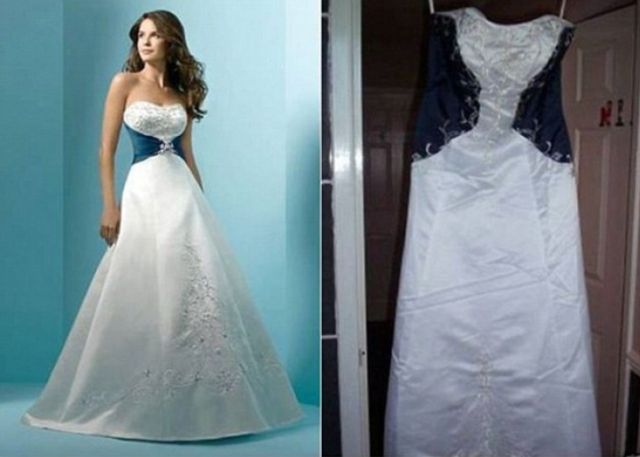The wedding dress is one of the central elements of a wedding, so choosing it is a very difficult one. Because she did not have time to go shopping and did not want to spend a lot of money, a young woman decided to order the model in the picture above from a site in China.
“I really liked the way it looks, and the price was excellent! I made sure to choose a measure that was as suitable for me as possible and I told myself that I would be able to take it to the tailor anyway, to make some adjustments “, she says.

But he would find out later what a huge fool he was! After two months of waiting, the package finally arrived at his door. Eagerly, she opened it immediately and tried on the dress, but soon began to cry!

It looks completely and completely different than in the photos. The materials used were of questionable quality and the cut was extremely poor. Now, on the eve of the wedding, the girl has to look for a new dress and waste a lot of time.
The Issue with Buying Low-Cost Items on the Internet
Wish.com and other such sites are cutting away the middlemen in the retail industry. Will this new dynamic appeal to customers?
The gift arrived in a little black box that was taped shut. It didn’t have a return address. A box labeled Smart Watch, with no brand name, was hidden beneath layers of packing. The watch itself was inside the box, and it didn’t look anything like the low-cost Apple Watch I had hoped for. Instead of “camera,” the enormous digital face displayed icons for Twitter, Facebook, a pedometer, and “Camina,” a photo-taking app. It was about what you’d expect for a smart watch under $20.
I bought the watch from Wish.com, one of a growing number of websites that allow people all around the world to buy substantially discounted goods directly from Chinese dealers or manufacturers. I could no longer resist Wish’s promotional emails offering bikinis for $ 4 (down from $ 75! ), camera drones for $ 29 (down from $ 1,399! ), and, for some reason, a spoon with the words “My Peanut-Butter Spoon” for $ 1 (down from $ 12). I ordered a smart watch for $ 18 that was described as a “Hot Sell New Product Q18S Smart Wrist Watch,” reportedly reduced down from $ 896. The product received over 8,000 evaluations in a variety of languages, with an average rating of four stars. One said, “It’s cool, I like it for the price.”
Wish represents a growing trend in e-commerce: consumers purchasing directly from Chinese manufacturers and merchants. Wish, AliExpress, LightInTheBox, and even Amazon have made it possible for more Chinese vendors to enter the US market, where they compete with American manufacturers and retailers who have been importing items from China. Despite the fact that some sites’ products take longer to arrive due to their origins in other countries, some analysts believe sites like Wish are the future of shopping. Forbes estimates that Wish is worth $8.5 billion, which is roughly the same as Macy’s, J.C. Penney, and Sears combined. Its value has more than doubled since it secured $ 500 million in investment a year ago. The Los Angeles Lakers now wear its logo on their uniforms.
Even with the development of e-commerce, these sites reflect a different form of buying that customers have been doing for decades. For long of the twentieth century, shoppers would drive to a store, explore rows of merchandise, and then buy the clothes, headphones, or cameras they desired before driving home. Then they’d go to store and retailer websites and order clothes, headphones, or cameras to be delivered to their homes. These new sites, on the other hand, are assisting consumers in bypassing the store middlemen by acting as the retailer intermediary themselves. People can buy inexpensive items like as bikinis or drones straight from the maker or vendor, regardless of where the business is located.
“You’ve always had retailers sell to customers as long as retail has existed, because many manufacturers were unsuitable to do so,” Juozas Kaziuknas, the founder and CEO of Marketplace Pulse, an e-commerce research site, told me. “However, as information has spread and it has grown easier, producers have begun to sell.” According to Kaziuknas, China accounts for up to one-third of Amazon’s merchants. Often, Chinese retailers will transport bulk products to the United States, where they will wait in Amazon, Wish, or other companies’ warehouses until they are ordered by U.S. enterprises, he added.
Though it’s difficult to quantify how big the direct-from-China business has become, the number of parcels arriving in the United States from other countries has exploded in recent years. According to the USPS, 175 million letters and packages were sent from abroad in the first three months of 2018, up from 97 million in the same period in 2013. The USPS makes it simple for Chinese sellers to ship inexpensively to the US: Merchants can transport items weighing less than 4.4 pounds and receive tracking and delivery confirmation services for a minimal fee through the ePacket program. Shipping a package from China to a U.S. destination is frequently less expensive than shipping the same item domestically.
Wish and other such sites have ushered in a new era of buying for clients who value inexpensive pricing above all else. Darlene Echaverria, 58, discovered Wish when looking for a gift for her grandson in 2016. He had requested a pair of Adidas Yeezy sneakers, which retail for around $300. Echaverria, a retired nurse, didn’t want to spend that much money on footwear, so she looked out a cheaper alternative on the internet. Her search led her to Wish, where she found a sneaker that looked comparable to the Yeezy for only $ 16. “It seemed too good to be true,” she explained. Her grandson adored them when they arrived after a few weeks, but she had ordered the wrong size, so Echaverria now wears them.
She’s bought dozens of items on Wish since then, including $ 4 bras, $ 6 pants, and a $ 60 coat. She bought a $ 400 pool vacuum cleaner on sale for $ 75, and she claims it still works. She thinks she purchased items from the site a few times per week until her husband nagged her to stop. The site may occasionally give her free items, such as apparel for her Chihuahua rat terrier if she pays for shipping. Because the goods aren’t from a store, they’re frequently packaged in unusual ways: Shoes are bubble-wrapped with no shoebox, and devices are delivered without any English instructions. People will like Wish, according to Echaverria, as long as they realize they’re getting a cheap commodity from China. “It’s important to keep your expectations in check. “If you don’t want to be disappointed,” she advises. “It’s not like you’re going to Dillard’s and buying a pair of jeans for $100.” You’ll get a pair of pants for $5. ”
Wish poses a big challenge to exporters and producers in the United States, who must compete with websites offering low-cost goods directly from China. “If you’re a manufacturer in the United States, you’re not happy about this,” Kaziuknas explained, “because you can’t create anything as cheaply as the Chinese firms can.” Because of the low cost of labor and loose labor laws, manufacturing items in China is substantially less expensive. That’s why buyers used to rush to places like Target and Walmart, where they could buy low-cost Chinese goods. Target and Walmart provided quality control, but sites like Wish perform effectively for those willing to take a chance. Why spend $40 on a bikini built in America when you can get one for $4 from China? Why buy a $ 20 bikini made in China but imported by a U.S. firm like Gap when you can buy a $ 4 bikini made in China directly?
Local governments trying to collect sales tax on things sold online face challenges because to sites like Wish. Because most Chinese merchants are third-party sellers, companies like Amazon and Wish are exempt from collecting sales tax on items sold in most states. (This practice is currently being challenged in court by a number of states.) Even if more states require third-party sellers to collect sales tax, it will be more difficult to enforce the law against Chinese enterprises than against those with a presence in the United States. “A lot of states claim that a lot of these Chinese corporations don’t pay any taxes because they are foreign organizations who don’t care,” Kaziuknas added.
Even Nevertheless, there are hints that some customers will not tolerate low-quality goods. As I’ve previously written, websites like Amazon that allow third-party sellers — including those in China — to sell counterfeit and knockoff products are facing a slew of lawsuits from customers and businesses who claim that the websites should be held liable when customers receive low-quality or counterfeit goods. One set of cases accuses Amazon of selling hoverboards from China with exploding batteries. Customers who purchase things from Wish or other direct-from-China websites may be so dissatisfied with their purchases that they will return to trusted brand-name retailers. “In this nation, we have a rather high standard for quality,” Sucharita Kodali, a retail analyst at Forrester, told me. “If people try it once and have a poor experience with it, they will never buy it again.”
Wish customer reviews indicate that many people have had negative encounters with the company. Wish has 512 customer reviews on Hiya.com, the majority of which are negative, with users labeling the company a “scam” and a “rip-off.” They complain of the site sending rings that tint fingers green, things that were paid for but never delivered, and requests for returns and refunds that were ignored. “Yes, if you actually get your item, you save money! Regina Ashley, a consumer, commented, “I will never order [sic] from Wish again.” (In an email, Ashley, a Virginia resident, acknowledged that she had submitted the review.)
Wish’s business plan and poor customer ratings piqued my interest, but the company doesn’t appear to have much of a presence in San Francisco, where its website claims its offices are situated. Wish displays a Google Map of downtown San Francisco on the “Contact Us” section, however there is no pin on the map to indicate where the company is located. I indicated I was a reporter seeking to speak with a spokesperson when I emailed support, which was the only way I could figure out how to reach Wish. “Unfortunately, it doesn’t sound like we require your skills at this moment,” a customer-support representative, Justin, wrote in an email. “But thank you for your interest and thank you for contacting us.” I didn’t get a response when I explained that I wasn’t looking for customer service, but rather a reporter.
My own Wish buying experience convinced me that I would not return to the site. No matter how hard I stomp, the pedometer on my “Smart Watch” does not register my steps. Reading the two-page user guide, which is printed in black and white.
